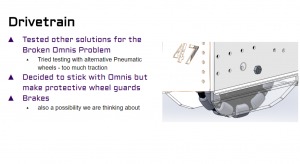Two weeks ago Nate Lavedure from FRC#2363 posted a fantastic white paper on making an integrated VersaPlanetary encoder. They had a very creative and simple approach to a problem many teams have been wanting to solve for some time.
Read their entire paper HERE and the forum thread about the paper HERE. All of the rest of this post is going to detail our implementation of the same setup. Thanks and credit should all go to FRC#2363 for their fantastic idea. You should read through their document first, as we will be pointing out our modifications but not detailing the entire process.
 We started by analyzing their setup and seeing if there are ways to simplify it or make it cheaper. The first thing we looked at was the gear they used for the sensor setup. 2363 used a 21 teeth, 24 pitch, 14.5° PA gear from McMaster Carr. This is a good choice as it fits in the space vacated by the bearing very well but it also costs about $20 making up the majority of the cost of this modification. We realized that we could use the gears from the VersaPlanetary Dual Input adapter hardware kit for a more inexpensive solution. Each kit can yield 3x 30 tooth gears that fit nicely in the required space.
We started by analyzing their setup and seeing if there are ways to simplify it or make it cheaper. The first thing we looked at was the gear they used for the sensor setup. 2363 used a 21 teeth, 24 pitch, 14.5° PA gear from McMaster Carr. This is a good choice as it fits in the space vacated by the bearing very well but it also costs about $20 making up the majority of the cost of this modification. We realized that we could use the gears from the VersaPlanetary Dual Input adapter hardware kit for a more inexpensive solution. Each kit can yield 3x 30 tooth gears that fit nicely in the required space.
We looked at possibly using other sensors as well but after researching, the
Allegro ATS605LSG is one of the best values for a gear tooth sensor that has quadrature output and can run off of 5v DC. When you buy x10 from Digikey the unit price drops by nearly $2 to only $6.70 each; this is a great value for an accurate encoder.
 Team 2363 also used a potting epoxy to seal in the encoder. The item they quote is very expensive and only sold in large quantities. We substituted the STYCAST 2850FT with ordinary sensor safe RTV silicone gasket maker. This item is only $6 and can be purchased from Amazon or your local hardware store. Make sure it’s sensor safe RTV silicone so that you don’t short out the contacts on the encoder when sealing it in the VersaPlanetary.
Team 2363 also used a potting epoxy to seal in the encoder. The item they quote is very expensive and only sold in large quantities. We substituted the STYCAST 2850FT with ordinary sensor safe RTV silicone gasket maker. This item is only $6 and can be purchased from Amazon or your local hardware store. Make sure it’s sensor safe RTV silicone so that you don’t short out the contacts on the encoder when sealing it in the VersaPlanetary.
For the drill bit we also looked at a low cost option. The requirements are a 17mm drill bit. The high quality
McMaster versions run around $26, a c
heap import drill bit from Amazon is only $11. If you are willing to wait a similar model to the Amazon item can be imported directly from China on
eBay or Aliexpress for around $7. These inexpensive models will not last very long but will get the job done and allow you to test the process.
We did most of the machining in a similar way to FRC#2363 but we also intentionally tried to do it somewhat quickly to see how imprecise you could be and still get a functional system. To drill the holes in the VP input stage we use a hand drill and hand marked the holes.
These holes were very imprecise. We ended up using a file and another drill bit to widen them until the sensor with the bent legs would fit.
We attempted to also drill out the gear with a hand drill but that was not going to be possible. The VEX gears appear to be some form of hardened steel and were very difficult to drill.
We ended up needing to use the lathe and to step up the drill bits in a similar fashion as FRC#2363 did. However because the gears are different there is no need to use a cut off tool because the ends of the gear that need to be removed just popped off during the drilling process since they are smaller than the final diameter of the 17mm hole. This means this step of the process can most likely be accomplished on a mill or a drill press as well, making it accessible to teams without the use of a lathe.
Here is the before and after photos for the gear that we used.
We used a Loctite retaining compound to secure the gear to the VP input coupler; but honestly you could probably use an epoxy or super glue since the gear does not have to transfer any torque.
The RTV silicone gasket material worked just fine for our purpose.
We left the RTV to dry over the weekend and came back on Monday to a fully cured product.
Here is the full working assembly.
We tested it today and are getting what appear to be good distance values out of the basic WPILIB encoder class. The rate function isn’t giving consistent results but that is somewhat to be expected with an encoder generating this many counts per second and the way that the WPILIB rate class operates. Writing a custom rate method that looks at the distance traveled over a certain amount of time will likely lead to more consistent results.
Overall this is a very inexpensive modification to make to the VersaPlanetary.
Simple Bill of Materials
17mm Drill Bit: $11 can be used for multiple gears until it will need to be sharpened
Wire, heat shrink, Loctite, other drill bits: already owned
Total cost for initial sensor addition ~$27, each additional gearbox will only be ~$10 for the sensor and gear.
This is an awesome modification and we are very thankful to FRC#2363 for posting this for everyone to use.
Comment below if you have any questions about this process. We think it’s within reach of most FRC teams to accomplish these mods.
– Spectrum
Help one another; there’s no time like the present and no present like the time. – James Durst
 We started by analyzing their setup and seeing if there are ways to simplify it or make it cheaper. The first thing we looked at was the gear they used for the sensor setup. 2363 used a 21 teeth, 24 pitch, 14.5° PA gear from McMaster Carr. This is a good choice as it fits in the space vacated by the bearing very well but it also costs about $20 making up the majority of the cost of this modification. We realized that we could use the gears from the VersaPlanetary Dual Input adapter hardware kit for a more inexpensive solution. Each kit can yield 3x 30 tooth gears that fit nicely in the required space.
We started by analyzing their setup and seeing if there are ways to simplify it or make it cheaper. The first thing we looked at was the gear they used for the sensor setup. 2363 used a 21 teeth, 24 pitch, 14.5° PA gear from McMaster Carr. This is a good choice as it fits in the space vacated by the bearing very well but it also costs about $20 making up the majority of the cost of this modification. We realized that we could use the gears from the VersaPlanetary Dual Input adapter hardware kit for a more inexpensive solution. Each kit can yield 3x 30 tooth gears that fit nicely in the required space. Team 2363 also used a potting epoxy to seal in the encoder. The item they quote is very expensive and only sold in large quantities. We substituted the STYCAST 2850FT with ordinary sensor safe RTV silicone gasket maker. This item is only $6 and can be purchased from Amazon or your local hardware store. Make sure it’s sensor safe RTV silicone so that you don’t short out the contacts on the encoder when sealing it in the VersaPlanetary.
Team 2363 also used a potting epoxy to seal in the encoder. The item they quote is very expensive and only sold in large quantities. We substituted the STYCAST 2850FT with ordinary sensor safe RTV silicone gasket maker. This item is only $6 and can be purchased from Amazon or your local hardware store. Make sure it’s sensor safe RTV silicone so that you don’t short out the contacts on the encoder when sealing it in the VersaPlanetary.












some of the picutres are not loading